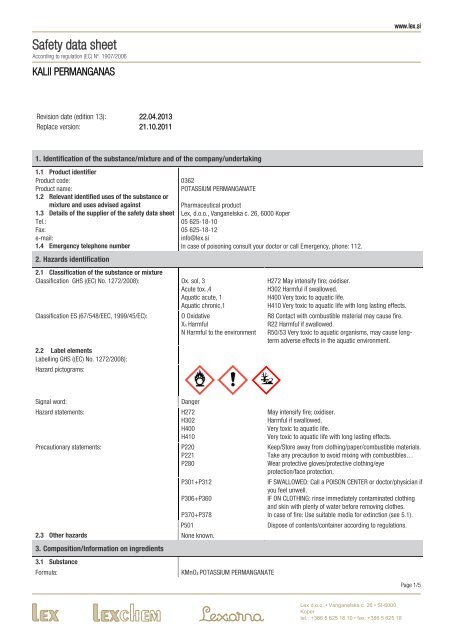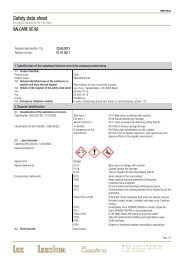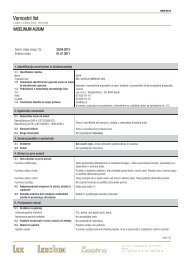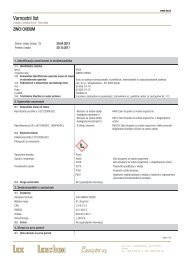Safety data sheet - Lex doo
Safety data sheet - Lex doo
Safety data sheet - Lex doo
You also want an ePaper? Increase the reach of your titles
YUMPU automatically turns print PDFs into web optimized ePapers that Google loves.
www.lex.si<br />
<strong>Safety</strong> <strong>data</strong> <strong>sheet</strong><br />
According to regulation (EC) N o . 1907/2006<br />
KALII PERMANGANAS<br />
Revision date (edition 13): 22.04.2013<br />
Replace version: 21.10.2011<br />
1. Identification of the substance/mixture and of the company/undertaking<br />
1.1 Product identifier<br />
Product code:<br />
Product name:<br />
1.2 Relevant identified uses of the substance or<br />
mixture and uses advised against<br />
1.3 Details of the supplier of the safety <strong>data</strong> <strong>sheet</strong><br />
Tel.:<br />
Fax:<br />
e-mail:<br />
1.4 Emergency telephone number<br />
0362<br />
POTASSIUM PERMANGANATE<br />
Pharmaceutical product<br />
<strong>Lex</strong>, d.o.o., Vanganelska c. 26, 6000 Koper<br />
05 625-18-10<br />
05 625-18-12<br />
info@lex.si<br />
In case of poisoning consult your doctor or call Emergency, phone: 112.<br />
2. Hazards identification<br />
2.1 Classification of the substance or mixture<br />
Classification GHS ((EC) No. 1272/2008): Ox. sol, 3<br />
Acute tox.,4<br />
Aquatic acute, 1<br />
Aquatic chronic,1<br />
Classification ES (67/548/EEC, 1999/45/EC):<br />
2.2 Label elements<br />
Labelling GHS ((EC) No. 1272/2008):<br />
Hazard pictograms:<br />
O Oxidative<br />
Xn Harmful<br />
N Harmful to the environment<br />
H272 May intensify fire; oxidiser.<br />
H302 Harmful if swallowed.<br />
H400 Very toxic to aquatic life.<br />
H410 Very toxic to aquatic life with long lasting effects.<br />
R8 Contact with combustible material may cause fire.<br />
R22 Harmful if swallowed.<br />
R50/53 Very toxic to aquatic organisms, may cause longterm<br />
adverse effects in the aquatic environment.<br />
Signal word:<br />
Hazard statements:<br />
Precautionary statements:<br />
Danger<br />
H272<br />
H302<br />
H400<br />
H410<br />
P220<br />
P221<br />
P280<br />
P301+P312<br />
P306+P360<br />
P370+P378<br />
P501<br />
2.3 Other hazards None known.<br />
May intensify fire; oxidiser.<br />
Harmful if swallowed.<br />
Very toxic to aquatic life.<br />
Very toxic to aquatic life with long lasting effects.<br />
Keep/Store away from clothing/paper/combustible materials.<br />
Take any precaution to avoid mixing with combustibles…<br />
Wear protective gloves/protective clothing/eye<br />
protection/face protection.<br />
IF SWALLOWED: Call a POISON CENTER or doctor/physician if<br />
you feel unwell.<br />
IF ON CLOTHING: rinse immediately contaminated clothing<br />
and skin with plenty of water before removing clothes.<br />
In case of fire: Use suitable media for extinction (see 5.1).<br />
Dispose of contents/container according to regulations.<br />
3. Composition/Information on ingredients<br />
3.1 Substance<br />
Formula:<br />
KMnO4 POTASSIUM PERMANGANATE<br />
Page 1/5<br />
<strong>Lex</strong> d.o.o. • Vanganelska c. 26 • SI-6000<br />
Koper<br />
tel.: +386 5 625 18 10 • fax: +386 5 625 18<br />
12<br />
www.lex.si • www.lexarna.si
<strong>Safety</strong> <strong>data</strong> Sheet (according to Regulation (EC) no. 1907/2006)<br />
KALII PERMANGANAS<br />
product code: 0362<br />
Molar mass:<br />
158 g/mol<br />
CAS: 7722-64-7<br />
EINECS: 231-760-3<br />
Index: 025-002-00-9<br />
Concentration: 100 %<br />
3.2 Mixtures No information available.<br />
4. First aid measures<br />
4.1 Description of first aid measures<br />
Inhalation:<br />
Skin contact:<br />
Eye contact:<br />
Ingestion:<br />
4.2 Most important symptoms and effects, both<br />
acute and delayed<br />
4.3 Indication of immediate medical attention and<br />
special treatment needed<br />
Take affected persons out of danger in a well ventilated area. In case of difficulty breathing<br />
immediately consult a doctor.<br />
Wash with water and rinse thoroughly. Immediately remove any clothing soiled by the product.<br />
Consult a doctor immediately. Wash separately contaminated clothing before reuse.<br />
Wash immediately and thoroughly with running water for at least 15 minutes. Consult a doctor.<br />
Immediately seek medical attention. Induce vomiting only if indicated by the doctor. Never give<br />
anything by mouth if the patient is unconscious.<br />
See chapter 11.<br />
Follow doctor’s instructions.<br />
5. Fire-fighting measures<br />
5.1 Extinguishing media<br />
Suitable extinguishing media:<br />
Unsuitable extinguishing media:<br />
5.2 Special hazards arising from the substance or<br />
mixture<br />
Specific hazards in case of fire:<br />
5.3 Advice for fire-fighters<br />
General:<br />
Special protective equipment for fire-fighters:<br />
CO2, dry chemicals. For leakage and spillage that have not been caught in fire, nebulised water<br />
can be used to disperse vapours and protect people involved.<br />
Do not use water jets. Water is not effective for extinguish fire, it can be used to cool container<br />
exposed to flames to prevent explosions.<br />
Avoid breathing products of combustion (carbon oxides, toxic products of pyrolysis, etc.).<br />
In case of fire cool containers with water spray to avoid explosion or development of potentially<br />
dangerous substances for health and safety. For information about risks to the environment,<br />
health, protection, see this <strong>data</strong> <strong>sheet</strong>.<br />
Protective helmet with visor, flame retardant clothing (jacket and trousers with bands around<br />
the arms, legs and waist), gloves for intervention (fire, chainsaw and dielectric), a mask with<br />
overpressure with a facial that covers the entire face of the operator or with the self contained<br />
breathing in case of large quantities of smoke.<br />
6. Accidental release measures<br />
6.1 Personal precautions: Eliminate all sources of ignition (cigarettes, flames, sparks, etc...) or any heat source from the<br />
area in which the loss occurred. Avoid formation of dust by sprinkling the product with water if<br />
there are no contraindications. In the case of airborne dust adopt respiratory protection. Stop<br />
the leak if there is no hazard. And do not handle damaged containers or spilled material without<br />
appropriate protective equipment. Keep away unprotected persons. For information on risks for<br />
the environmental and health protection, ventilation and personal protection equipment refer to<br />
other sections of this <strong>sheet</strong>.<br />
6.2 Environmental precautions Prevent product from entering into drains, surface water, and ground water and in confined<br />
areas.<br />
6.3 Methods and materials for containment and<br />
cleaning up<br />
Absorb liquid spill with inert absorbent material (sand, vermiculite, diatomaceous earth, etc.) in<br />
suitable container (made from material not incompatible with the product). Collect the majority<br />
of material and deposit it in containers for disposal. For solid product use spark proof<br />
mechanical tools and deposit it in plastic container. Discard the residue with water spray if<br />
there are no contraindications. Ensure adequate ventilation of the place. The disposal of<br />
contaminated material must be in accordance with paragraph 13.<br />
6.4 Reference to other sections Indications about personal protection and waste treatment see sections 8 and 13.<br />
7. Handling and storage<br />
Page 2/5<br />
<strong>Lex</strong> d.o.o. • Vanganelska c. 26 • SI-6000<br />
Koper<br />
tel.: +386 5 625 18 10 • fax: +386 5 625 18<br />
12<br />
www.lex.si • www.lexarna.si
<strong>Safety</strong> <strong>data</strong> Sheet (according to Regulation (EC) no. 1907/2006)<br />
KALII PERMANGANAS<br />
product code: 0362<br />
7.1 Precautions for safe handling Do not smoke during the work. Work in accordance with good working practice.<br />
7.2 Conditions for safe storage, including any<br />
incompatibilities<br />
7.3 Specific end uses No information available.<br />
8. Exposure controls/personal protection<br />
8.1 Control parameters No information available.<br />
8.2 Exposure controls<br />
Hygiene measures:<br />
Respiratory protection:<br />
Hand protection:<br />
Store in tightly closed container in cold and well ventilated place, away from heat, open<br />
flames, sparks and other ignition sources.<br />
Given that the use of appropriate technical measures should always take priority over personal<br />
protective equipment (ensure good ventilation in the workplace through effective local<br />
extraction or with the discharge of stale air). If these precautions do not maintain the<br />
concentration of the product under exposure limit values in the workplace, wear appropriate<br />
respiratory protection. Use the product in the reference to the label of danger for details. During<br />
the choice of personal protective equipment if necessary, request advice from suppliers of<br />
chemicals. The personal protective equipment must conform to the regulations below.<br />
In case of exceeding the threshold value of one or more of the substances in the preparation or<br />
the daily reported exposure at work or at a fraction established by the service of prevention and<br />
corporate security, wear a filter semiofficially type FFP3 (ref. Standard EN 141). The use of<br />
respiratory protection, such as masks with cartridge for organic vapour and dust / mist, it is<br />
necessary in the absence of technical measures to limit worker exposure. Where the substance<br />
in question is odourless or its olfactory threshold is higher than the relative exposure limit and<br />
in case of emergency, or when exposure levels are unknown or the oxygen concentration in the<br />
workplace is less than 17% volume, wear self-circuit compressed mask with open air (ref.<br />
Standard EN 137) or breathing apparatus with air hose for use with full face mask, half mask or<br />
mouthpiece (ref. Standard EN 138). Provide a system for emergency eyewash and shower. If<br />
there is a risk of being exposed to splashes or sprays in relation to work, you should provide<br />
adequate protection of mucous membranes (mouth, nose, eyes) in order to avoid accidental<br />
absorptions.<br />
Protect your hands with gloves category I (ref. Directive 89/686/EEC and EN 374) such as PVC,<br />
latex or equivalent. In the final selection of glove material must be considered: degradation,<br />
permeation and breakthrough times. In the case of preparations the resistance of gloves must<br />
be tested before use because it is not predictable. The gloves have a time to wear that depends<br />
on the duration of exposure.<br />
Eye protection: Use suitable safety glasses – hermetic (reference standard EN 166).<br />
Skin and body protection:<br />
9. Physical and chemical properties<br />
9.1 Information on basic physical and chemical properties<br />
Form:<br />
Colour:<br />
Odour:<br />
Wear work clothes with long sleeves and safety footwear. Professional use of category I (ref.<br />
Directive 89/686/EEC and EN 344). Wash with soap and water after removing clothing<br />
protective.<br />
crystals<br />
dark violet<br />
odourless<br />
Melting point:
<strong>Safety</strong> <strong>data</strong> Sheet (according to Regulation (EC) no. 1907/2006)<br />
KALII PERMANGANAS<br />
product code: 0362<br />
11. Toxicological information<br />
11.1 Information on toxicological effects<br />
Acute effect:<br />
12. Ecological information<br />
Harmful if swallowed. Even small amounts of ingested can cause several problems with<br />
symptoms including nausea, abdominal pain, vomiting, and diarrhea. May cause irritation of<br />
mucous membranes, upper respiratory tract and eyes. Symptoms of exposure may include<br />
burning and irritation to the eyes, mouth, nose, throat, cough, difficulty breathing, dizziness,<br />
headache, nausea and vomiting.<br />
12.1 Toxicity Very toxic to aquatic organisms, may cause long-term adverse effects in the aquatic<br />
environment.<br />
Morone saxatilis LC50 (96h) 0,96 mg/l<br />
Daphnia magna EC50 (48h) 0,084 mg/l<br />
Aphanizomenon flos-aquae IC50 (72h) 0,18 mg/l<br />
12.2 Persistence and degradability No information available.<br />
12.3 Bioaccumulative potential No information available.<br />
12.4 Mobility in soil No information available.<br />
12.5 Results of PBT and vPvB assessment No information available.<br />
12.6 Other adverse effects Use product with good working habits and do not allow it, to reach ground water, water course<br />
or sewage system.<br />
13. Disposal considerations<br />
13.1 Waste treatment methods<br />
Product:<br />
Packaging:<br />
14. Transport information<br />
Reuse, if possible. The residues of the product are to be considered special hazardous waste.<br />
<strong>Lex</strong> product packaging must be disposed of in compliance with the country specific regulations<br />
or must be passed to a packaging return system. Under www.slopak.si you will find special<br />
information on the respective national conditions.<br />
Chemicals must be disposed of in compliance with the respective national regulations. Under<br />
www.slopak.si you will find country and substance specific information for disposal.<br />
ADR:<br />
UN-Number:<br />
Proper shipping name:<br />
Class:<br />
Packing group:<br />
Hazard identification No:<br />
Limited quantities:<br />
1090 1490<br />
acetone Potassium permanganate<br />
35.1<br />
II<br />
33 50<br />
LQ4 LQ11<br />
15. Regulatory information<br />
15.1 <strong>Safety</strong>, health and environmental regulations/legislation specific for the substance or mixture<br />
Classification GHS ((EC) No. 1272/2008)<br />
NIOSH -Registry of toxic effects of chemicals substances (1983)<br />
I.N.R.S. -Fiche toxicologique<br />
15.2 Chemical <strong>Safety</strong> Assessment No chemical safety assessment has been processed for the mixture and the substances it<br />
contains.<br />
16. Other information<br />
Full text of H-Statements referred to under section 2.<br />
H272 May intensify fire; oxidiser.<br />
H314 Causes severe skin burns and eye damage.<br />
H400 Very toxic to aquatic life.<br />
H410 Very toxic to aquatic life with long lasting effects.<br />
Full text of R-phrases referred to under section 2.<br />
H272 May intensify fire; oxidiser.<br />
H302 Harmful if swallowed.<br />
H400 Very toxic to aquatic life.<br />
H410 Very toxic to aquatic life with long lasting effects.<br />
Page 4/5<br />
<strong>Lex</strong> d.o.o. • Vanganelska c. 26 • SI-6000<br />
Koper<br />
tel.: +386 5 625 18 10 • fax: +386 5 625 18<br />
12<br />
www.lex.si • www.lexarna.si
<strong>Safety</strong> <strong>data</strong> Sheet (according to Regulation (EC) no. 1907/2006)<br />
KALII PERMANGANAS<br />
product code: 0362<br />
Further information<br />
Other information: This version replaces all previous versions.<br />
Page 5/5<br />
<strong>Lex</strong> d.o.o. • Vanganelska c. 26 • SI-6000<br />
Koper<br />
tel.: +386 5 625 18 10 • fax: +386 5 625 18<br />
12<br />
www.lex.si • www.lexarna.si
















